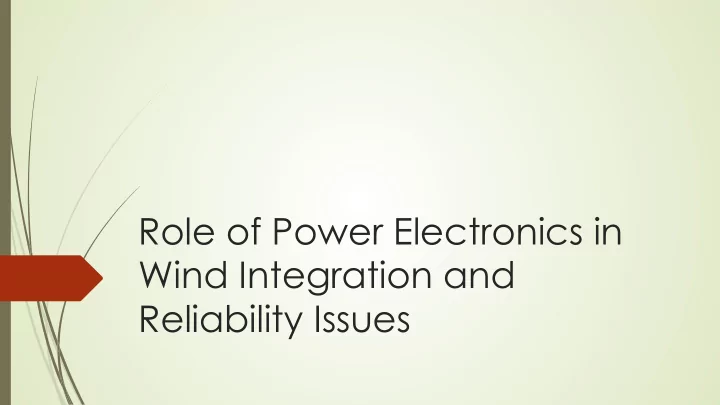

Role of Power Electronics in Wind Integration and Reliability Issues
Wind Integration Challenges: ´ Variability ´ Uncertainty ´ Asynchronism Solutions: ´ Demand Response ´ Energy Storage ´ Improved Wind Forecasting Techniques
Types of Wind Turbine Generators Type 1: Induction generator–fixed speed Type 2: Wound-rotor induction generator with adjustable external rotor resistance–variable slip
Types of Wind Turbine Generators Type 3: Double-fed induction generators (DFIG)– variable speed Type 4: Full converter system with permanent magnet synchronous generator —variable speed, direct drive
Active Power Control Swing Equation: Types of Active Power Control: ´ Inertial Control ´ Primary Frequency Control ´ Regulation and Automatic Generation Control
Active Power Control- Inertial Control Inertial Control Characteristics of Wind Turbine Generators: Where 𝐾 is wind rotor inertia [ 𝑙 · 𝑛 2], and Δ 𝜕 is change in rotor speed. ´ Then, the power released can be estimated as Δ 𝑄 = Δ 𝐹 / Δ 𝑢 [watt] ´ For instance, the 1.5 MW wind turbine is capable of releasing up to 200 kW from the inertia in 15 s when the wind rotors slow down by 5 RPM from initial speed.
Active Power Control- Inertial Control Inertial Control Characteristics of Type 1 and Type 2 WTG Model Design: Illustration of kinetic energy transfer during a frequency decline for Type 1 and 2 WTGs.
Active Power Control- Inertial Control Inertial Control Characteristics of Type 1 and Type 2 WTG Model Design: • In this illustration, a large 2 MW Type 1 wind turbine is used. Simplified governor-based power system model.
Inertial Control Characteristics of Type 1 WTG Model Design: • The inertial response energy released is delivered at a peak power value of 40 kW with a duration of about 1 second. • As the frequency drops, the output power of the WTG increases from 1.94 MW up to 1.98 MW. Frequency response of Type 1 WTG connected to a power system with large inertia.
Inertial Control Characteristics of Type 1 WTG Model Design: Frequency response of Type 1 WTG connected to a power system with low inertia.
Type 1 and Type 2 Wind Turbine Generator— Power Speed Characteristic Output power versus rotor speed (Type 2 WTG). Output power versus rotor speed (Type 1 WTG).
Active Power Control- Inertial Control Inertial Control Characteristics of Type 3 and Type 4 WTG Model Design: Illustration of kinetic energy transfer during a frequency decline for Type 3 and 4 WTGs.
Inertial Control Characteristics of Type 3 and Type 4 WTG Model Design: Frequency response of Type 3 and Type 4 WTG
Active Power Control- Primary Frequency Control (frequency responsive reserve and governor droop service) PFC implemented with a frequency droop on a wind power plant.
Active Power Control When a disturbance occurs, the frequency of the electric power system deviates from its scheduled level. The frequency must be stabilized and returned to its scheduled level to avoid further reliability issues
Impact of Wind Penetration Levels and APC Strategies on Frequency response WI frequency response for 15% wind power penetration.
Impact of Wind Penetration Levels and APC Strategies on Frequency response WI frequency response for 50% wind power penetration.
Impact of Wind Penetration Levels and APC Strategies on Frequency response Impact of wind power controls on frequency nadir
Impact of Wind Penetration Levels and APC Strategies on Frequency response Impact of wind power controls on settling frequency
Active Power Control-Status
Recommend
More recommend